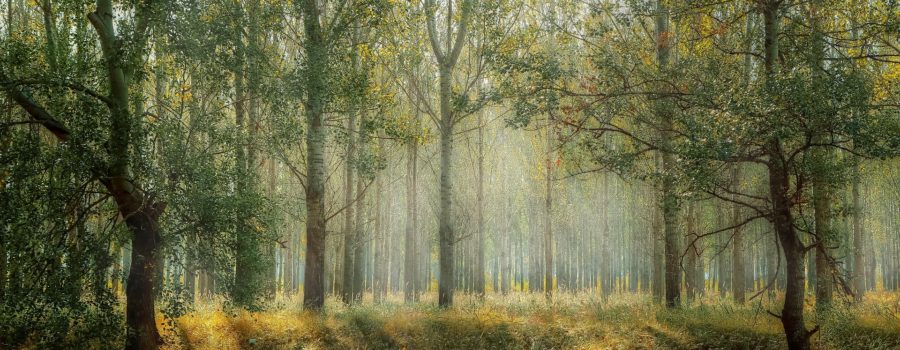Picture a large, bustling city for me right now. Imagine all of the cars, loud sounds, rushing people, bright and flashing lights, and constant commotion.
Think of how that polluted air smells. Do you feel congested at all? Perhaps there is a sense of anxiety or increased stress.
Now, get rid of that imagery and instead focus on imagining a forest scene. Imagine all of the trees, rushing waters, birds chirping and flying through the air, and the ground squirrels running through the rocks.
Visualize taking in a big, deep breath, and imagining how that clean, crisp air feels as you breathe it in. Are you feeling relaxed? Maybe a sense of calmness and ease is setting in.

Nature and Intuition
I give this simple example to illustrate what was already part of your intuition. All of us, I’m assuming, understand that nature is beneficial for us in so many ways, yet we don’t spend nearly enough time in it to receive the full benefits. And, given the fact that nature has now been scientifically proven to benefit us in so many ways, it is time for us to start spending more time in nature and experiencing “forest therapy”.
Forest Therapy/Forest Bathing
The term has also been called “forest bathing”, but you really don’t need to attach any fancy term to it. The researchers just did this so they could have a term to analyze. Forest bathing can mean anything you’re doing in nature. Whether that be hiking, walking, biking, meditating, yoga, hunting, or simply just sitting. All of these activities yield the same benefits from being in nature.
Lowered Stress Levels
The first benefit is that spending time in nature reduces overall stress levels. Spending time in the forest has been proven to suppress the sympathetic nervous system and facilitate the parasympathetic nervous system. As a result, exposing oneself to nature has been proven to lower pulse rate, lower blood pressure, and decrease cortisol levels (cortisol is a stress hormone). In addition, overall stress levels are reduced by way of an increase in positive feelings and a decrease in negative feelings.
Lower Levels of Rumination
Related somewhat to the first benefit, spending time in nature has also been proven to significantly lower rumination. Taking a walk in nature, as opposed to an urban area, significantly lowers persistent worrisome and anxiety-producing thoughts and actually decreases activity in the brain linked to risk for mental illness. Simply put, you just don’t worry as much about your life problems when you’re surrounded by the relaxing scenery of nature, as opposed to hectic city life.
Decreased Depression and Anxiety
Chronically elevated stress levels have been shown to drastically increase symptoms of anxiety and depression. Therefore, given the first two benefits (lowered stress levels and lowered rumination), it is not surprising that spending time in nature can drastically reduce depressive symptoms and lowers symptoms of anxiety as well, especially when done on a regular basis.
It has also been shown that those with the most severe depressive symptoms actually find the most benefit from spending time in nature. Similarly, those who experienced the highest levels of chronic stress and anxiety also benefited the most from forest therapy.
Grounding?
Another way nature can benefit you is through an effect called grounding. Now, for this benefit, you have to have bare feet when you are out in nature. Essentially, there is ionic energy in ourselves and the Earth, and touching the Earth with bare feet allows for the exchange of these charged particles.
Why is this important? Because we usually build up a high positive charge in our body, and this positive charge is associated with things such as depression and inflammation. However, when you walk barefoot in nature, the Earth will exchange a negative charge and ultimately balance yourself out. The results of this balance are a decrease in depression and inflammation, and improved recovery time related to any illnesses, aches, or injuries. Sounds crazy and a little “hippy”, I know. But the benefits are real!
Boosted Immune System
Finally, one of the last major benefits of forest therapy is an increased immune system function. For this, I will have to go a bit scientific again, but I’ll keep it as basic as possible. There is an aromatic compound found in trees called phytoncides. These phytoncides are essential oils, and your body gets exposed to them when you are in the forest. And these phytoncides have been scientifically proven to improve Natural Killer (NK) cell function in the human body.
Why are NK cells important? Well, NK cells are a type of white blood cell which is responsible for ridding the body of foreign invaders. So, as a result of exposure to phytoncides, your NK cells function better, ultimately boosting your immune system and ridding you of infection and disease at a more efficient rate.
There are even more benefits of spending time in nature, yet I wanted to highlight the major ones just to give you an idea of how powerful this can be.
Benefit Your Mind and Body
When considering the extensive benefits of nature, one really shouldn’t be all that surprised. Nature is the place humans used to spend all of their lives, and as a result, our bodies adapted to that.
This is why the simple act of spending time in nature has enormous health benefits and offers an improvement in both physiological and psychological functioning. It doesn’t matter whether you spend your time in nature hiking, biking, walking, hunting, or simply sitting.
Whatever your choice is, you can be confident in knowing that taking this time gives you a much-needed break from our sometimes hectic and stressful world. As a result, you’ll be a better functioning and happier person, with a more optimized mind and body.
References:
Bratman, G. N., Hamilton, J. P., Hahn, K. S., Daily, G. C., & Gross, J. J. (2015). Nature experience reduces rumination and subgenual prefrontal cortex activation. Proceedings of the National Academy of Sciences of the United States of America, 112(28), 8567–8572. http://doi.org/10.1073/pnas.1510459112
Lee, J., Tsunetsugu, Y., Takayama, N., Park, B., Li, Q., Song, C., . . . Miyazaki, Y. (2014). Influence of Forest Therapy on Cardiovascular Relaxation in Young Adults. Evidence-Based Complementary and Alternative Medicine,2014, 1-7. doi:10.1155/2014/834360
Li, Q. (2010). Effect of forest bathing trips on human immune function. Environmental Health and Preventive Medicine, 15(1), 9–17. http://doi.org/10.1007/s12199-008-0068-3
Morita, E., Fukuda, S., Nagano, J., Hamajima, N., Yamamoto, H., Iwai, Y., . . . Shirakawa, T. (2007). Psychological effects of forest environments on healthy adults: Shinrin-yoku (forest-air bathing, walking) as a possible method of stress reduction. Public Health,121(1), 54-63. doi:10.1016/j.puhe.2006.05.024
Ochiai, H., Ikei, H., Song, C., Kobayashi, M., Miura, T., Kagawa, T., . . . Miyazaki, Y. (2015). Physiological and Psychological Effects of a Forest Therapy Program on Middle-Aged Females. International Journal of Environmental Research and Public Health,12(12), 15222-15232. doi:10.3390/ijerph121214984
Oschman, J. L., Chevalier, G., & Brown, R. (2015). The effects of grounding (earthing) on inflammation, the immune response, wound healing, and prevention and treatment of chronic inflammatory and autoimmune diseases. Journal of Inflammation Research, 8, 83–96. http://doi.org/10.2147/JIR.S69656
Park, B. J., Tsunetsugu, Y., Kasetani, T., Kagawa, T., & Miyazaki, Y. (2009). The physiological effects of Shinrin-yoku (taking in the forest atmosphere or forest bathing): Evidence from field experiments in 24 forests across Japan. Environmental Health and Preventive Medicine,15(1), 18-26. doi:10.1007/s12199-009-0086-9
Shin, W. S., Shin, C. S., & Yeoun, P. S. (2011). The influence of forest therapy camp on depression in alcoholics. Environmental Health and Preventive Medicine,17(1), 73-76. doi:10.1007/s12199-011-0215-0
Takayama, N., Korpela, K., Lee, J., Morikawa, T., Tsunetsugu, Y., Park, B., . . . Kagawa, T. (2014). Emotional, Restorative and Vitalizing Effects of Forest and Urban Environments at Four Sites in Japan. International Journal of Environmental Research and Public Health,11(7), 7207-7230. doi:10.3390/ijerph110707207




